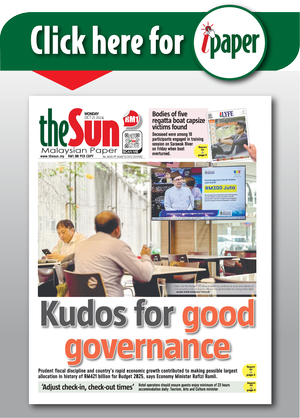KUALA LUMPUR: Hong Leong Bank Bhd (HLB) remains confident that Malaysia’s economy will stay on a stable growth path in 2026, expressing optimism that the nation is on track to achieve its targeted gross domestic product (GDP) growth of 4.5% next year.
HLB general manager of fixed income and economic research Choong Yin Pheng said the banking group attributed its optimism to two key factors – domestic demand is expected to remain resilient, supported by strong private consumption.
“We are seeing stronger realisation of investment projects, which will continue to support the domestic economy.
“Externally, while uncertainties remain, we expect conditions to stabilise as we move into next year – a development that should further drive Malaysia’s growth.
“That said, downside risks persist, particularly with the unresolved impact of semiconductor tariffs, which could pose the biggest challenge ahead,” she told delegates at Hong Leong Bank’s roundtable entitled “Decoding Budget 2026: What It Means for Malaysia’s Growth” today.
The roundtable also featured insights from Taylor’s University adjunct professor Prof Dr Ong Kian Ming, Small and Medium Enterprises Association of Malaysia (Samenta) national president Datuk William Ng, and PwC Malaysia tax partner Ang Wei Liang.
Choong said the total fiscal outlay of RM417 billion marks a steady improvement in fiscal management, narrowing the budget shortfall to RM75 billion in 2026 – down from RM77 billion in the revised 2025 Budget.
She noted that the increased participation of government-linked investment companies and government-linked companies in development spending has helped ease pressure on government coffers, with operating expenditure at 81% and development expenditure at 19%.
On revenue, Choong highlighted that Sales and Service Tax (SST) collection has risen steadily to nearly 2.8% of gross domestic product (GDP), comparable to the Goods and Services Tax era, while petroleum-related income has declined, a sign of reduced reliance on oil revenues.
Subsidy reforms, she added, have led to more targeted cash assistance, with subsidies expected to account for 44% of social spending next year, down from 75% previously.
“Malaysia’s fiscal consolidation is on track, with the deficit improving from 4.1% of GDP in 2024 to 3.5% in 2026,” Choong said, adding that this trend supports the country’s sovereign rating outlook.
She projected GDP growth of 4% to 4.5% and inflation between 1.3% and 2% next year, aligning with the Ministry of Finance’s forecast.
“Despite global uncertainties, Malaysia’s economy remains resilient, supported by stable growth, manageable inflation, and healthy fundamentals. We do not expect Bank Negara to cut the OPR (Overnight Policy Rate) further,” she said.
HLB also expects the ringgit to strengthen gradually, forecasting RM4.20 to the US dollar by end-2025, and RM4.10 within 12 months, driven by narrowing rate differentials with the US, sustained growth, and continued investment inflows.
Meanwhile, Ong said Budget 2026 strikes a generally balanced approach in encouraging both foreign direct investment (FDI) and domestic direct investment (DDI), while maintaining policy consistency under the government’s ongoing economic reforms.
He explained that new FDI requires greater confidence than existing investors, while DDI depends heavily on Malaysia’s economic and political stability.
“Budget 2026 should be seen as a continuation of the government’s governance story since 2024, reflecting consistent policy direction and structural reforms.”
Ong highlighted three key strengths: political stability under Prime Minister Datuk Seri Anwar Ibrahim, Malaysia’s balanced geopolitical positioning between global powers, and policy clarity through initiatives such as the National Energy Transition Roadmap and the New Industrial Master Plan.
However, Ong noted areas for improvement, including stronger commitment to implementing announced plans, avoiding policy surprises such as the recent SST expansion and sudden excise hikes on alcohol and tobacco, and maintaining predictable communication with the business community.
He also cautioned against populist narratives that target the Mahakaya or wealthy groups, stressing that such rhetoric could backfire if not matched with well-calibrated subsidy and tax policies.
“Overall, Budget 2026 continues Malaysia’s steady policy momentum, but execution and consistency will determine its real impact on investment confidence,” said Ong.
Samenta described Budget 2026 as a “safe but modest” fiscal plan that addresses some SME challenges but falls short of easing rising business costs and compliance burdens.
Ng said SMEs continue to face the “three Cs and two Ws” – rising costs, compliance and credibility, along with issues related to workers and wages.
“While Budget 2026 introduces positive measures such as expanding the Syarikat Jaminan Pembiayaan Perniagaan credit guarantee from RM20 billion to RM30 billion, more can be done to tackle escalating operating and compliance costs,” he said.
Ng pointed out that many hidden cost pressures stem from increased agency and state fees, citing, for example, expatriate visa charges that surged by 250% last year, as well as new fees from agencies such as the Malaysian Investment Development Authority, Malaysia External Trade Development Corporation and TalentCorp.
He added that under the 13th Malaysia Plan, greater efforts are needed to streamline government agencies and improve efficiency to reduce the cost of doing business.
“Overall, it’s a stable and cautious budget, but SMEs were hoping for stronger measures to ease business costs and improve ease of doing business,” said Ng.









